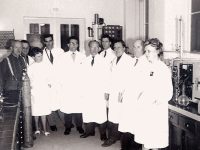
Science and Exile. Spanish Republican Scientists and their History of Wandering.
The end of the Civil War also ended a period of scientific and cultural development, which had taken place during the Republic. Scientists and intellectuals who had been part of academic life, and often political life too, were faced with the choice of staying in Spain or going into exile abroad after the Francoist victory. Those deciding to stay, suffered repression under Franco and a kind of «internal exile», away from their professional career, while those who fled had to face the difficulties of being in countries where there was mixed reception.
In order to understand the significance of republican exile on Spanish science we will need to observe, if only briefly, the decades prior to the Civil War. From 1907 to 1936 a series of new institutions and organisations boosted research and science production extraordinarily. All of this was part of a modernisation process to get closer to Europe that started at the end of the nineteenth century with the ideas of the Free Teaching Institute (Institución Libre de Enseñanza, ILE) and would end in 1907 with the creation in Madrid of the Council for the Extension of Studies and Scientific Research (Junta para la Ampliación de Estudios e Investigaciones Científicas, JAE), whose main goal was to give grants for Europe to graduates. In Catalonia, under different social and political circumstances, the Institute for Catalan Studies (Institut d’Estudis Catalans, IEC) had the same interest in intellectual and scientific modernisation, and was key for the development of medical and biological research.
«Many of the most valuable representatives of our country were exiled from these institutions or subdued in a sort of internal exile»
Other institutions such as the Student’s Residence, created in Madrid in 1910, and the laboratories around said organisation – physiology, histology or microbiology, among others – will also push scientific and technological renovation forward. We have to add that in the field of physical chemistry – and after years of sharing physical proximity with the National Museum for Natural Science, the Laboratory of Automatics or the Aeronautics Centre – the Laboratory for Physics Research moved to a nearby independent building and turned into the National Institute for Physics and Chemistry in 1932, in close collaboration with the Rockefeller Foundation. Many of the most valuable representatives of our country were exiled from these institutions or subdued in a sort of internal exile.
With the leaving of the republican army and thousands of people, both through the French border and from Valencian harbours, a pilgrimage started that would bring Spanish citizens to different countries in the world. France would be the destination for most of the exiles, a significant number of whom would eventually come back to Spain. Of those who stayed in France, most will stay definitely despite all the hardship they would experience, especially due to the German occupation during World War II.
(Full text available in Catalan and Spanish)





